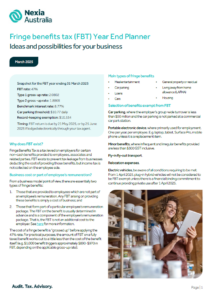Snapshot for the FBT year ending 31 March 2025
FBT rate: 47%
Type 1 gross-up rate: 2.0802
Type 2 gross -up rate: 1.8868
Benchmark interest rate: 8.77%
Car parking threshold: $10.77 daily
Record-keeping exemption: $10,334
Timing: FBT return is due by 21 May 2025, or by 25 June 2025 if lodged electronically through your tax agent.
Why does FBT exist?
Fringe Benefits Tax is a tax levied on employers for certain non-cash benefits provided to employees, associates and related parties. FBT exists to prevent tax leakage from businesses deducting the cost of providing those benefits, but income tax is not collected on the employee side.
Business cost or part of employee’s remuneration?
From a business model point of view, there are essentially two types of fringe benefits:
- Those that are provided to employees which are not part of an employee’s remuneration. Any FBT arising on providing these benefits is simply a cost of business; and
- Those that form part of a particular employee’s remuneration package. The FBT on the benefit is usually determined in advance and is a component of the employee’s remuneration package. That is, the FBT is not an additional cost to the employer. See here for more information.
The cost of a fringe benefit is “grossed up” before applying the 47% rate. For practical purposes, the amount of FBT on a fully taxed benefit works out to a little less than the cost of the benefit itself. (eg, $1,000 benefit triggers approximately $890-$970 in FBT, depending on the applicable gross-up rate.)
Main types of fringe benefits
- Cars
- Car parking
- Meal entertainment
- Loans
- Housing
- Living away from home allowance (LAFHA)
- General property or residual
Selection of benefits exempt from FBT
Car parking, where the employer’s group-wide turnover is less than $50 million and the car parking is not parked at a commercial car park station.
Portable electronic device, where primarily used for employment. One per year, per employee. Eg, Laptop, tablet, Surface Pro, mobile phone unless it is a replacement item.
Minor benefits, where infrequent and irregular benefits provided are less than $300 GST inclusive.
Fly-in fly-out transport.
Relocation expenses.
Electric Vehicles, be aware of all conditions requiring to be met. From 1 April 2025, plugin hybrid vehicles will not be considered to be FBT exempt unless there is a financial binding committment to continue providing private use after 1 April 2025.
Selection of benefits not subject to full FBT
Cars, usually depending on their use. Also, a simplified FBT calculation method is available for a fleet of 20 or more qualifying cars. Also be aware of the requirements when providing dual cab utes to employees.
First $1,000 of in-house benefits (eg. Insurance company providing insurance coverage to employees) is exempt (N/A under a salary packaging arrangement).
Employee contributions, to the extent an employee reimburses the employer from after-tax salary.
Otherwise deductible, to the extent an employee would be entitled to a one-off deduction, had they personally incurred the cost of the benefit.
Employers who are exempt from FBT, or have reduced/limited FBT exposure
- Public Benevolent Institutions (eg, certain charities).
- Public hospitals.
- Certain not-for-profit organisations.
Reportable Fringe Benefits
Where the taxable value is greater than $2,000, the grossed-up amount of certain fringe benefits is reported on an employee’s PAYG payment summary. The minimum grossed-up value is $3,773 (being $2,000 multiplied by the Type 2 gross-up rate).
Although the employee does not pay income tax on that amount, it factors into calculating various means-tested benefits such as;
- Liability to the Medicare levy surcharge
- Child support payments and benefits
- Recovery of HELP debt (previously known as HECS)
- Income tests for youth allowance, family tax benefit and childcare benefit
- Personal and spouse’s super contribution rebate
Think about the possibilities in your business
As you work through your 2025 FBT compliance, think about the possibilities in your organisation for next year. Talk to your trusted Nexia advisor about how we can help you better manage the provision of benefits, and get the best outcomes for you and your employees.
FBT Year End Planner - Ideas and possibilities for your business
Download PDf






